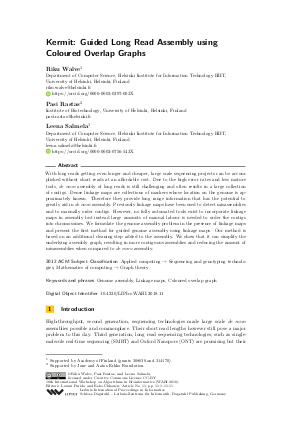Kermit: Guided Long Read Assembly using Coloured Overlap Graphs
Authors
Riku Walve  ,
Pasi Rastas,
Leena Salmela
,
Pasi Rastas,
Leena Salmela 
-
Part of:
Volume:
18th International Workshop on Algorithms in Bioinformatics (WABI 2018)
Part of: Series: Leibniz International Proceedings in Informatics (LIPIcs)
Part of: Conference: International Conference on Algorithms for Bioinformatics (WABI) - License:
 Creative Commons Attribution 3.0 Unported license
Creative Commons Attribution 3.0 Unported license
- Publication Date: 2018-08-02
File

PDF
LIPIcs.WABI.2018.11.pdf
- Filesize: 420 kB
- 11 pages
Document Identifiers
Subject Classification
ACM Subject Classification
- Applied computing → Sequencing and genotyping technologies
- Mathematics of computing → Graph theory
Keywords
- Genome assembly
- Linkage maps
- Coloured overlap graph
Metrics
- Access Statistics
-
Total Accesses (updated on a weekly basis)
0Document
0Metadata
Abstract
With long reads getting even longer and cheaper, large scale sequencing projects can be accomplished without short reads at an affordable cost. Due to the high error rates and less mature tools, de novo assembly of long reads is still challenging and often results in a large collection of contigs. Dense linkage maps are collections of markers whose location on the genome is approximately known. Therefore they provide long range information that has the potential to greatly aid in de novo assembly. Previously linkage maps have been used to detect misassemblies and to manually order contigs. However, no fully automated tools exist to incorporate linkage maps in assembly but instead large amounts of manual labour is needed to order the contigs into chromosomes. We formulate the genome assembly problem in the presence of linkage maps and present the first method for guided genome assembly using linkage maps. Our method is based on an additional cleaning step added to the assembly. We show that it can simplify the underlying assembly graph, resulting in more contiguous assemblies and reducing the amount of misassemblies when compared to de novo assembly.
Cite As Get BibTex
Riku Walve, Pasi Rastas, and Leena Salmela. Kermit: Guided Long Read Assembly using Coloured Overlap Graphs. In 18th International Workshop on Algorithms in Bioinformatics (WABI 2018). Leibniz International Proceedings in Informatics (LIPIcs), Volume 113, pp. 11:1-11:11, Schloss Dagstuhl – Leibniz-Zentrum für Informatik (2018)
https://doi.org/10.4230/LIPIcs.WABI.2018.11
BibTex
@InProceedings{walve_et_al:LIPIcs.WABI.2018.11,
author = {Walve, Riku and Rastas, Pasi and Salmela, Leena},
title = {{Kermit: Guided Long Read Assembly using Coloured Overlap Graphs}},
booktitle = {18th International Workshop on Algorithms in Bioinformatics (WABI 2018)},
pages = {11:1--11:11},
series = {Leibniz International Proceedings in Informatics (LIPIcs)},
ISBN = {978-3-95977-082-8},
ISSN = {1868-8969},
year = {2018},
volume = {113},
editor = {Parida, Laxmi and Ukkonen, Esko},
publisher = {Schloss Dagstuhl -- Leibniz-Zentrum f{\"u}r Informatik},
address = {Dagstuhl, Germany},
URL = {https://drops.dagstuhl.de/entities/document/10.4230/LIPIcs.WABI.2018.11},
URN = {urn:nbn:de:0030-drops-93135},
doi = {10.4230/LIPIcs.WABI.2018.11},
annote = {Keywords: Genome assembly, Linkage maps, Coloured overlap graph}
}
Author Details
- Department of Computer Science, Helsinki Institute for Information Technology HIIT, University of Helsinki, Helsinki, Finland
Funding
- Walve, Riku: Supported by Academy of Finland (grants 308030 and 314170).
- Rastas, Pasi: Supported by Jane and Aatos Erkko Foundation.
References
-
V. Ahola, R. Lehtonen, P. Somervuo, et al. The Glanville fritillary genome retains an ancient karyotype and reveals selective chromosomal fusions in Lepidoptera. Nature Communications, 5:4737, 2014.

-
B. Alipanahi, L. Salmela, S.J. Puglisi, M. Muggli, and C. Boucher. Disentangled long-read de Bruijn graphs via optical maps. In R. Schwartz and K. Reinert, editors, WABI 2017, volume 88 of LIPIcs, pages 1:1-1:14, Dagstuhl, Germany, 2017.

-
A. Bankevich, S. Nurk, D. Antipov, et al. SPAdes: a new genome assembly algorithm and its applications to single-cell sequencing. J Comput Biol., 19(5):455-477, 2012.

-
S.M. Van Belleghem, P. Rastas, A. Papanicolalaou, et al. Complex modular architecture around a simple toolkit of wing pattern genes. Nature Ecology &Evolution, 1:0052, 2017.

-
J. Catchen. Chromonomer. http://catchenlab.life.illinois.edu/chromonomer/, 2015. Accessed: 2018-04-27.

-
G. Chartrand, GL. Johns, KA. McKeon, and P. Zhang. Rainbow connection in graphs. Mathematica Bohemica, 133(1):85-98, 2008.

-
C.-S. Chin, P. Peluso, F.J. Sedlazeck, et al. Phased diploid genome assembly with single-molecule real-time sequencing. Nature Methods, 13:1050-1054, 2016.

-
J.L. Fierst. Using linkage maps to correct and scaffold de novo genome assemblies: methods, challenges, and computational tools. Frontiers in Genetics, 6:220, 2015.

-
A. Gurevich, V. Saveliev, N. Vyahhi N, and G. Tesler. QUAST: quality assessment tool for genome assemblies. Bioinformatics, 29(8):1072-1075, 2013.

-
M. Kolmogorov, J. Yuan, Y. Lin, and P. Pevzner. Assembly of long error-prone reads using repeat graphs. In Proc. RECOMB 2018, pages 261-263, 2018.

-
S. Koren, B.P. Walenz, K. Berlin, J.R. Miller, N.H. Bergman, and A.M. Phillippy. Canu: scalable and accurate long-read assembly via adaptive k-mer weighting and repeat separation. Genome Res., 27:722-736, 2017.

-
H. Li. Minimap and miniasm: fast mapping and de novo assembly for noisy long sequences. Bioinformatics, 32(14):2103-2110, 2016.

-
H. Li. Minimap2: pairwise alignment for nucleotide sequences. Bioinformatics, 2018. (To appear).

-
H.C. Lin, S. Goldstein, L. Mendelowitz, S. Zhou, J. Wetzel, D.C. Schwartz, and M. Pop. AGORA: assembly guided by optical restriction alignment. BMC Bioinformatics, 13:189, 2012.

-
T. Paterson and A. Law. ArkMAP: integrating genomic maps across species and data sources. BMC Bioinformatics, 14:246, 2013.

-
R. Vaser R, I. Sovic, N. Nagarajan, and M. Sikic. Fast and accurate de novo genome assembly from long uncorrected reads. Genome research, 27:737-746, 2017.

-
P. Rastas. Lep-MAP3: robust linkage mapping even for low-coverage whole genome sequencing data. Bioinformatics, 33(23):3726-3732, 2017.

-
J. Salojärvi, O.P. Smolander, K. Nieminen, et al. Genome sequencing and population genomic analyses provide insights into the adaptive landscape of silver birch. Nature Genetics, 49:904-912, 2017.

-
K. Schneeberger, S. Ossowski, F. Ott, et al. Reference-guided assembly of four diverse Arabidopsis thaliana genomes. PNAS, 108(25):10249-10254, 2011.

-
B.K. Stöcker, J. Köster, and S. Rahmann. SimLoRD: Simulation of long read data. Bioinformatics, 32(17):2704-2706, 2016.

